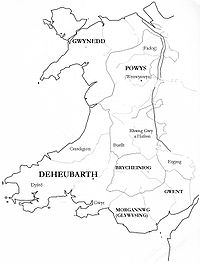Bernard de Neufmarché

Bernard de Neufmarché (c. 1050 – c. 1125), also Bernard of Newmarket or Bernard of Newmarch was the first of the
His toponymic byname comes from Neuf-Marché in Normandy. It was Latinised as de Novo Mercato (literally: "from the new market"), and has sometimes been Anglicised as "Newmarket" or "Newmarch".
Coming to England
Because Bernard's family had attachments to the monastery of
The question of Bernard's participation in the
Rise to power
Bernard was finally rewarded by
Probably as a consequence of his rapid rise in the marches, Bernard attracted the attention of Osbern fitzRichard, who gave him his daughter, Agnes (Nest), whose mother was the Welsh princess Nest, daughter of Gruffydd ap Llywelyn and Edith of Mercia, in marriage sometime before 1099.[8] She brought with her a dowry of Berrington and Little Hereford.
All of Bernard's estates lay in the valley of the
Conquest of Brycheiniog
Bernard joined the
The chronology of events at this juncture is often confused. Bernard may well have already been in power in Brycheiniog by 1088 if he had already inherited a claim to it after the defeat of Roger de Breteuil, Earl of Hereford, in 1075. In 1088 the king, William Rufus, confirmed a previous charter of Bernard's stating that he had already made an exchange "within his lordship of Brycheiniog" at Glasbury. He also already held Castell Dinas which had probably been built by the Earl of Hereford before 1075.
After the initial conquest of 1088, Bernard continued warring with Brycheiniog until 1090, probably supported by
There is some discrepancy in this description of events also. Richard Fitz Pons was lord of Llandovery, which he had reached probably through Glamorgan, already by 1088. Bronllys Castle may not have been built until 1144, when Roger Fitzmiles, Earl of Hereford, is first recorded granting it as a five-knight's-fee mesne barony to Walter de Clifford, son of Richard Fitz Pons.
According to much later accounts and reconstructions, of dubious accuracy but which contain some references to verifiable history, the king of Brycheiniog,
Reliable historical records refer to no king of Brycheiniog after a Tewdwr ab Elise who died after 934. Certainly there is no contemporary reference to a Bleddyn ap Maenarch. The Welsh Bruts simply state that "Rhys ap Tewdwr, king of Deheubarth, was slain by the Frenchmen who were inhabiting Brycheiniog." This passage lends evidence to the belief that the conquest of Brycheiniog was mostly finished by Eastertide 1093 and that the main effect of the battle of Brecon was to open the way to the conquest of Deheubarth.
Pacification and administration of Brycheiniog
He followed the Usk down to
Two expeditions from Glamorgan came to the rescue of the garrisons of Brycheiniog. The first was crushed in battle at Celli Carnant, but the second defeated the rebels at Aber Llech.[16] What followed was the complete encastellation of Brycheiniog. Among the castles possibly built during Bernard's lordship to defend the entrances to Brycheiniog from the southeast were Tretower, Blaen Llyfni (not attested before 1207–1215), and Crickhowell.
Bernard also extensively enfeoffed his followers with Welsh land.[16] Richard Fitz Pons may have been enfeoffed at Cantref Selyff on the western border of Brycheiniog and immediately he began in miniature the process whereby Bernard had come to rule Brycheiniog.[16] However, Richard's son Walter is the first recorded landholder at Cantref Selyff. Furthermore, Bernard enfeoffed the sons of the king he had displaced in the less habitable land, thereby creating a loyal Welsh aristocracy and extracting more out of his land than the Normans otherwise knew how to do.[17] The Normans lived predominantly in the valleys and lowlands in an agrarian society while the Welsh kept to the hills and mountains living pastorally, thus creating an overall economic gain.[18] Among Bleddyn's sons, Gwrgan received Blaen Llyfni and Aberllyfni while Caradog received an unnamed hill country, and Drymbenog, Bleddyn's brother, was given land neighbouring that of Richard Fitz Pons.
Death and succession
Bernard died around 1125 and was buried at
References
Notes
- ^ Nelson, 123.
- ^ Nelson, 83.
- ^ a b Nelson, 84.
- ^ Nelson, 83. He was not, as sometimes claimed, a half-brother of the Conqueror, but, rather, a distant cousin.
- ^ a b c d Nelson, 85.
- ^ Nelson, 86. Barlow, 321.
- ^ Nelson, 86.
- ^ Nelson, 86. There has been confusion in the past regarding Bernard's wife's identity. He had only one wife and Nest was not his second wife but rather his mother-in-law.
- ^ Nelson, 87.
- ^ Nelson, 81.
- ^ Nelson, 88.
- ^ a b Nelson, 89.
- ^ Nelson, 82.
- ^ Nelson, 90 and n25.
- ^ a b Nelson, 90 and n26.
- ^ a b c Nelson, 91.
- ^ Nelson, 92.
- ^ Nelson, 93.
- ^ Holt, 7.
Bibliography
- Barlow, Frank. William Rufus. 1983.
- Holt, J. C. "Presidential Address: Feudal Society and the Family in Early Medieval England: IV. The Heiress and the Alien." Transactions of the Royal Historical Society, 5th Ser., Vol. 35. (1985), pp 1–28.
- Hunt, William (1885). . In Stephen, Leslie (ed.). Dictionary of National Biography. Vol. 4. London: Smith, Elder & Co.
- Maund, K. L.. "Neufmarché, Bernard de (d. 1121x5?)". Oxford Dictionary of National Biography. Oxford University Press, 2004.
- Nelson, Lynn H. The Normans in South Wales, 1070–1171. University of Texas Press: Austin, 1966.
- Remfry, P. M. Hay on Wye Castle, 1066 to 1521. ISBN 1-899376-07-0.
- Remfry, P. M. Castell Bwlch y Dinas and the Families of Fitz Osbern, Neufmarché, Gloucester, Hereford, Braose, Fitz Herbert. ISBN 1-899376-79-8.
